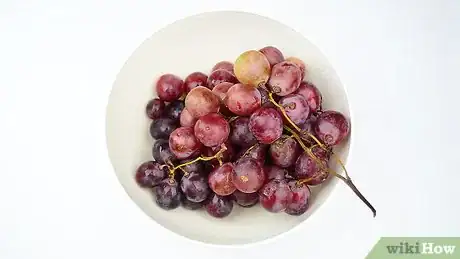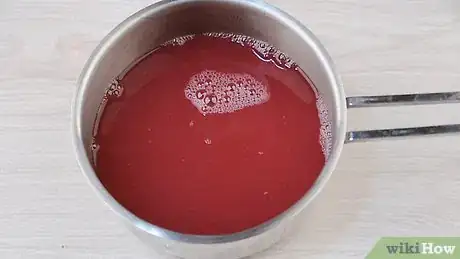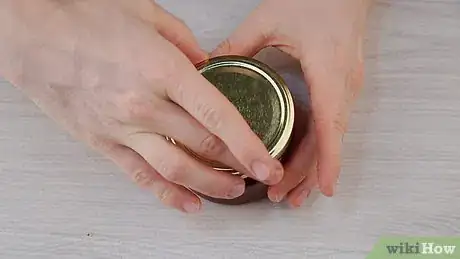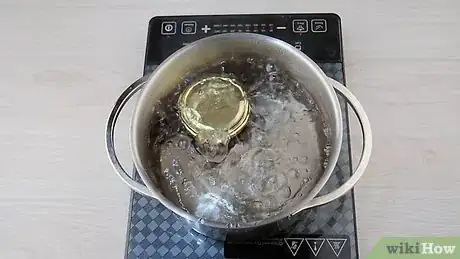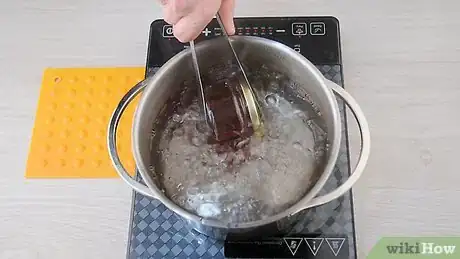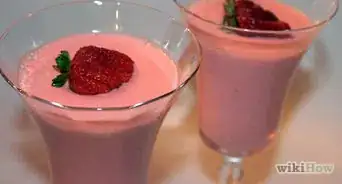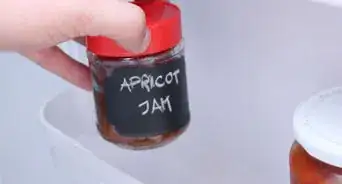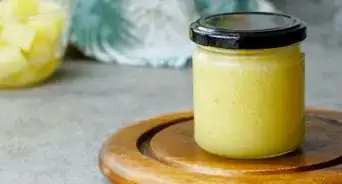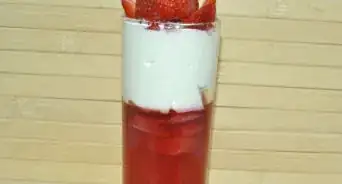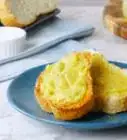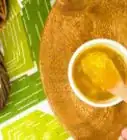This article was co-authored by wikiHow Staff. Our trained team of editors and researchers validate articles for accuracy and comprehensiveness. wikiHow's Content Management Team carefully monitors the work from our editorial staff to ensure that each article is backed by trusted research and meets our high quality standards.
There are 7 references cited in this article, which can be found at the bottom of the page.
The wikiHow Video Team also followed the article's instructions and verified that they work.
This article has been viewed 268,420 times.
Learn more...
Grape jelly is an easy and delicious recipe that requires little more than grapes, sugar, and fruit pectin. However, you’ll also need plenty of time on your hands, as the process of turning whole grapes into smooth jelly can take a while if you don’t know what you’re doing. By knowing how to boil grapes down to make juice, turn that juice into jelly, and store it properly, you can have grape jelly that’ll keep for nearly a year.
Ingredients
- 4 pounds (1.8 kg) of fresh grapes
- 1⁄2 cup (120 ml) of water
- 8 tablespoons (1 packet) of fruit pectin
- 7 cups (1.4kg) of white sugar
Steps
Cooking Your Grapes
-
1Start with around 4 pounds (1.8 kg) of grapes. The better quality grapes you choose, the better quality jelly you’ll have once you finish cooking them. While red or Concord grapes are the most common when making jelly, there’s no right grape to choose. Pick a grape that you like the taste of and that you can get a lot of.[1]
- You can use either seeded or seedless grapes, as well as grapes that are green, white, or red. This will affect the look and taste of your finished jelly, but it will be delicious nonetheless.
- If you don’t have easy access to fresh grapes or don’t want to cook them into juice yourself, you can use grape juice instead and skip to Part 2. Make sure the grape juice you choose is made fresh and doesn’t have any added sugar.[2]
-
2Take the grapes off their stems and wash them. Go through and methodically pick the grapes off the stems before throwing the grapes into a large bowl or colander. Once all the grapes have been removed from the stems, use cold water to give them a good wash and to rinse away any dirt or anything else you don’t want in your jelly.[3]
- If you’re particularly worried about your grapes being clean, or if you notice any bugs on them as you de-stem them, give the grapes a slight squeeze over your cooking bowl to split the fruit from its skin. This will let you see if anything is wrong with the inside of the grape and easily remove the skin.
Advertisement -
3Transfer the grapes to a large pot and add 1⁄2 cup (120 ml) of water. Place a big, heavy-bottomed pan over an element on your stovetop and pour in your grapes. Add around 1⁄2 cup (120 ml) of water to the pot. This should be just enough to stop your grapes from scorching without watering down your juice too much.[4]
- Depending on the size of your pot, you may need to add more water to stop the grapes from burning. This is absolutely fine. It’s much better to have a very slightly weaker grape jelly than it is to have jelly that tastes burnt.
-
4Crush the grapes up slightly. This will help release some of the grape juice and speed up the cooking process overall. Use a potato masher or a large wooden spoon to press the grapes down into the bottom of the pan, squishing them slightly. Repeat until all of the grapes are slightly crushed.[5]
- If you don’t want to crush your grapes and cook them to remove the juice, you can run them through a juicer instead. This may take a little longer but will give you a perfectly pure grape juice to turn into jelly.
-
5Bring the grapes to a boil and then simmer. Turn the element on your stove to a medium-high heat and bring your grapes to a boil, stirring occasionally to prevent them from sticking or burning. Once they have reached a boil, reduce the heat to low so that your grapes can begin simmering.[6]
- Bringing your grapes to a boil for the first time might take a while. Have patience and let them cook to bring out the most juice.
-
6Simmer the grapes for around 10 minutes. Once the grapes have lowered to a simmer, cover the pot and leave it to cook for approximately 10 minutes. Every few minutes, take the lid off the pot and give the grapes a stir with a large wooden spoon to move them around and agitate them a little.[7]
- Simmering your grapes is what will extract all of the juice and give you something to work with when making jelly. Keep the temperature low and let them cook.
-
7Strain the grapes to collect at least 4 cups of juice. After the grapes have been given time to simmer and are sitting in a lot of liquid, you need to strain them. Place a cheesecloth in a strainer over a large bowl, or use a jelly bag or strainer to separate the juice from the pulp. Slowly and carefully pour the juice through your strainer, being careful not to spill any.[8]
- If you don’t want to strain your juice, you could also process the juice and the pulp in a blender or food processor until it makes a smooth puree. This will change the texture of your jelly slightly, but will also be much easier than using a sieve.
- It may take a while for the juice to strain through the fabric strainers. You can use something to squeeze the grapes and speed up the process, or just leave it overnight to strain by itself.[9]
- This is a good point to begin preparing any jars that you’ll be using to store your jelly.
Turning Grape Juice into Jelly
-
1Pour 4 cups (1 liter) of grape juice into a large pan. Once you have your homemade or fresh, storebought grape juice, measure out 4 cups to pour into a large, heavy-bottomed pot. Make sure there’s room in the pot so that you can add the sugar and pectin and still be able to easily stir the juice once you have.[10]
- If you like, you can clean out the pot you used to juice the grapes and reuse it to make the jelly.
-
2Add 8 tablespoons (1 packet) of fruit pectin and bring to a boil. Fruit pectin is a natural ingredient which helps your jelly set as it cools, and should be available at your local supermarket. Place your pot of juice over a medium-high heat and pour the pectin in. Stir vigorously to combine and let the juice come to a boil.[11]
- To prevent the pectin from clumping and make it easier to mix in, try combining it with 1/2 a cup (100g) of the sugar before adding it. This will separate the pectin and incorporate it into the juice more easily.
- If you want to cut down on the sugar, use a low-sugar pectin instead. This will reduce the amount of sugar needed from 7 cups (1.2kg) to 4 cups (800g).
-
3Mix in 7 cups (1.2kg) of white, granulated sugar. Measure out your sugar exactly and pour it into the juice just as it begins to boil. This might seem like a lot of sugar, but all of it's necessary to turn your juice into jelly. Use a wooden spoon to stir in the sugar until it is dissolved.[12]
- When you add sugar and bring the juice to a boil, foam might start appearing on the top of your liquid. You can skim this off as it appears with a slotted spoon, or you can add 1/2 tablespoon (7g) of butter into the juice to keep it from foaming.[13]
-
4Bring the mixture to a hard boil for 1 minute. Stirring in the sugar will lower the temperature of the juice slightly, so you will need to bring it to a boil once again. Stir the juice occasionally until it comes to a boil, then set a timer for exactly 1 minute and begin stirring constantly. After 1 minute, set the heat as low as it can go to stop the juice from overcooking.[14]
- Be very careful when working with the juice after this point. It will be made up mostly of melted sugar, which is very hot. Make sure that you don’t splash the juice as you stir it, otherwise, you may burn yourself.
- To make sure that your jelly has had enough time to cook and that it will set properly, dip a chilled metal spoon into the jelly once you’ve finished boiling it. Let the jelly on the spoon cool and check that it sets at your preferred consistency. If it’s not thick enough, bring the juice to a boil for one more minute to thicken it up.
Storing Your Jelly
-
1Sterilize 8 to 12 glass canning jars. In order to preserve your jelly for as long as possible, you need to use glass jars designed for canning that have been sterilized. Bring a large pot of water to a boil and place each jar in for 10 minutes. Use jar tongs or kitchen tongs to lift the jars out and rest them upside down on a tea towel until they are ready to be used.[15]
- If you have a big enough pot to boil all of the jars at once, you can also leave the jars in the water until you’re ready for them.
- Boiling the jars will sterilize them and remove anything on the inside that could rot and ruin your jam. If you don’t sterilize your jars, your jam will only last for around a week.
-
2Submerge your jar rings and lids in hot water. Put all of the lids and rings for your canning jars into a large, heat-proof bowl and pour hot water over them. Make sure that they are all covered in hot water and leave them to sit until you are ready to use them.[16]
- As with the jars themselves, the lids and rings for the jars need to be sterilized in order to preserve your jam.
- You do not need to use boiling water when sterilizing the jar rings and lids. Boiling water may break down the sealing compound on the lids and prevent your jars from sealing properly.
-
3Pour the jelly into the jars, leaving 1⁄4 inch (0.64 cm) of space at the top. Use a small glass measuring jug or ladle to scoop up the hot jam, being careful not to touch it with your hands. Position a jar funnel over the mouth of your jar and pour the jam in, leaving between 1⁄4 inch (0.64 cm) and 1⁄2 inch (1.3 cm) of space at the top.[17]
- If you spill any jam over the side or edge of the jar, immediately use a clean, damp cloth to wipe it away. Stray jam may stop the jars from sealing properly and ruin your preserve.
- Make sure the jars are hot or at least warm when you pour the jam in. Pouring hot jam into a cold jar might shock the jar and make it crack.
- The 1⁄4 inch (0.64 cm) space left at the top of the jar is called the "headspace," which is important in ensuring that your jars seal properly.
-
4Cover the jars with lids. Carefully lift a jar lid out of the water, shake any excess water off, and place the lid over the jar. Repeat the process with a jar ring, screwing it on tightly to hold the lid in place while it seals.[18]
- If the jars are too hot to handle, use a tea towel to hold the lids and rings as you work with them or to hold the jar still as you screw the lids on.
-
5Return the sealed jars to boiling water for 10 minutes. Once all of the jars have been filled and lidded, bring the pot of water used to sterilize the jars back to a boil again. Place the jars into the water once it has boiled, letting the jars cook for 10 minutes. This will drive out excess air, extend the shelf life of your jam, and result in a better seal.[19]
- Each jar should be given plenty of time in the water, and the water should be at least covering the entire jar.
-
6Leave the jars to cool overnight. Use kitchen or jar tongs to lift the jars from the boiling water and set them aside to cool. It will take around 12 hours for the jars to cool completely, so it is best to leave them overnight.[20]
- As the jars cool, you may hear popping noises coming from them. Don’t worry! This is a great sign, as it indicates that your jars are vacuum sealing and will last for a long time.
-
7Remove the ring and check that the jars have sealed. Once the jars have had plenty of time to cool, you will need to remove the ring and make sure that each of them has sealed properly. Press down on the middle of the lid and listen for a popping or clicking sound. If the lid moves at all or makes a noise, it has not sealed properly. If the lid stays in place, your jar is sealed and your jam will last much longer.[21]
- You can also check that your jars have sealed by attempting to lift the jars up by the lid. A properly sealed jar should be airtight and easily lifted.
- If your jelly hasn’t sealed, you can take it out of the jar and attempt to reseal it. Sterilize the jar once again, place a jar ring and a new lid in hot water, and bring the jelly to a boil. Follow the same process as before to try and seal your jar once again.
- If you want to leave the jar rings on the jelly jars for extra safety, make sure that you loosen them a little before storing. Otherwise, they may rust to the lid and prove difficult to remove when you’ve got a jelly craving!
-
8Store your jam for up to 12 months. If the grape jelly jars have sealed properly, they will store for up to 12 months while sealed. Keep them in your cupboard or give them away as gifts to friends.[22]
- If you don’t seal your jars, the jelly will only keep for around 1 week in the refrigerator before starting to turn bad.
- After 6 to 8 months, the color of your jelly may begin to darken and become slightly runnier. They will still be safe to eat but may be less appetizing. For the best results, eat your jelly within 6 months of preparing it.
Community Q&A
-
QuestionHow long can you keep picked grapes in the refrigerator?
 Community AnswerGrapes will last about a week in the fridge.
Community AnswerGrapes will last about a week in the fridge. -
QuestionWhat should I do when the jelly is not thick?
 Community AnswerSpoon it onto toast or pour it on pancakes. If you've made it right, it should still taste wonderful. Keep it in the refrigerator, and use it up in a reasonable period so it doesn't grow mold.
Community AnswerSpoon it onto toast or pour it on pancakes. If you've made it right, it should still taste wonderful. Keep it in the refrigerator, and use it up in a reasonable period so it doesn't grow mold. -
QuestionWhy didn't my jelly thicken up?
 Community AnswerYou may have used the incorrect amount of pectin, which is what causes the jelly to set. Read the instructions carefully and ensure that you're adding the proper amount of pectin for the recipe.
Community AnswerYou may have used the incorrect amount of pectin, which is what causes the jelly to set. Read the instructions carefully and ensure that you're adding the proper amount of pectin for the recipe.
Things You’ll Need
- Colander
- Large, heavy-bottomed pot
- Wooden spoon or potato masher
- Cheesecloth or jelly strainer
- Strainer
- Measuring cup
- Wooden spoon
- Canning jars
- Jar lids and rings
- Canning pot, or something similar
- Kitchen or jar tongs
- Jar funnel
- Tea towels
References
- ↑ https://www.shelovesbiscotti.com/homemade-concord-grape-jelly/
- ↑ http://pickyourown.org/grapejelly.htm
- ↑ https://www.shelovesbiscotti.com/homemade-concord-grape-jelly/
- ↑ https://nchfp.uga.edu/how/can_07/extract_juice.html
- ↑ https://www.shelovesbiscotti.com/homemade-concord-grape-jelly/
- ↑ https://www.shelovesbiscotti.com/homemade-concord-grape-jelly/
- ↑ https://www.shelovesbiscotti.com/homemade-concord-grape-jelly/
- ↑ http://pickyourown.org/grapejelly.htm
- ↑ http://pickyourown.org/grapejelly.htm
- ↑ https://www.shelovesbiscotti.com/homemade-concord-grape-jelly/
- ↑ http://pickyourown.org/grapejelly.htm
- ↑ https://youtu.be/rB378roYmSY?t=433
- ↑ https://youtu.be/rB378roYmSY?t=392
- ↑ https://www.shelovesbiscotti.com/homemade-concord-grape-jelly/
- ↑ https://www.nytimes.com/2012/09/19/dining/canning-jam-from-preparing-the-jars-to-testing-the-seal.html?_r=0
- ↑ https://www.nytimes.com/2012/09/19/dining/canning-jam-from-preparing-the-jars-to-testing-the-seal.html?_r=0
- ↑ https://youtu.be/rB378roYmSY?t=581
- ↑ https://www.nytimes.com/2012/09/19/dining/canning-jam-from-preparing-the-jars-to-testing-the-seal.html?_r=0
- ↑ https://www.nytimes.com/2012/09/19/dining/canning-jam-from-preparing-the-jars-to-testing-the-seal.html?_r=0
- ↑ http://pickyourown.org/grapejelly.htm
- ↑ https://www.nytimes.com/2012/09/19/dining/canning-jam-from-preparing-the-jars-to-testing-the-seal.html?_r=0
- ↑ https://www.shelovesbiscotti.com/homemade-concord-grape-jelly/
About This Article
To make grape jelly, start by adding 4 pounds of grapes and 1/2 cup of water to a large pot and bringing the water to a boil. Then, reduce the heat to low and simmer the grapes for 10 minutes. Next, strain the grapes to collect the juice and pour the juice back into the pot, adding 8 tablespoons of fruit pectin. After you add the fruit pectin, bring the mixture to a boil and mix in 7 cups of granulated sugar. Finally, boil the mixture for 1 minute before transferring the jelly to sterilized glass jars. To learn how to jar homemade grape jelly, scroll down!
